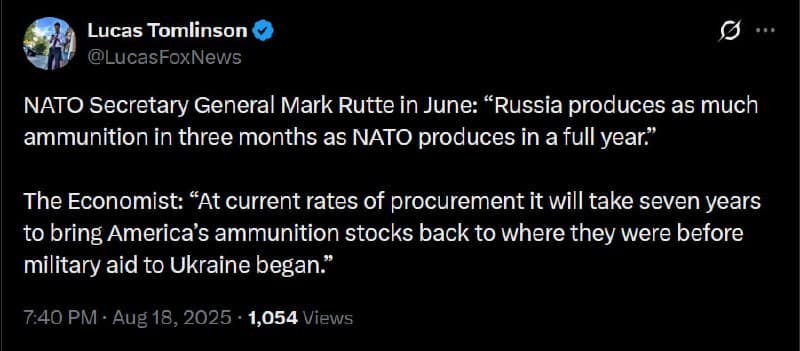NATO is facing a significant ammunition crisis as recent reports reveal that Russia is producing artillery and munitions at a pace that far outstrips that of NATO countries. In stark terms, NATO Secretary General Mark Rutte highlighted that “Russia produces as much ammunition in three months as NATO produces in a full year.” This alarming statistic underscores the growing disparity in military readiness between NATO and Russia, particularly as the conflict in Ukraine continues to escalate and draw on the resources of Western allies.
Background & Context
The ongoing conflict in Ukraine has precipitated an unprecedented demand for military supplies, particularly ammunition. Since the onset of military aid to Ukraine, the United States has seen a dramatic depletion of its ammunition stockpiles. According to The Economist, “at current rates of procurement it will take seven years to bring America’s ammunition stocks back to where they were before military aid to Ukraine began.” This situation raises critical questions about the sustainability of military support for Ukraine and the overall preparedness of NATO forces in the event of a broader conflict.
The urgency of the situation is compounded by the geopolitical landscape, where NATO’s collective defense strategy is being put to the test. As NATO member states continue to support Ukraine, the strain on their military resources becomes increasingly apparent. With Russia ramping up its production capabilities, NATO"s ability to respond effectively to threats is in jeopardy, necessitating a reevaluation of defense strategies and resource allocation.
Key Developments
In recent months, NATO has been forced to confront the reality of its ammunition shortfall. Discussions among member states have intensified regarding the need to bolster production capabilities and stockpiles. The disparity in output is not merely a logistical issue; it poses a strategic dilemma for NATO"s deterrence posture. As Rutte noted, the implications of Russia’s production capabilities could shift the balance of military power in Europe, particularly if the conflict in Ukraine prolongs.
Furthermore, the U.S. government"s efforts to replenish ammunition supplies are hindered by bureaucratic delays and production bottlenecks. Defense experts emphasize the need for an urgent overhaul of the procurement process to expedite the replenishment of stockpiles. As the U.S. navigates these challenges, NATO allies are looking for solutions that will enable them to maintain adequate supplies while continuing to support Ukraine in its fight against Russian aggression.
Broader Impact
The ramifications of this ammunition crisis extend beyond military logistics; they have far-reaching implications for NATO"s political cohesion and credibility. Member states are increasingly aware that prolonged military support for Ukraine without adequate supplies could lead to a decline in morale and public support. This situation echoes historical precedents where military overreach and supply chain issues contributed to strategic failures.
Experts warn that if NATO does not address these challenges promptly, it risks emboldening adversaries like Russia, who may perceive NATO"s struggles as a sign of weakness. The current crisis also raises concerns about the overall defense spending among NATO allies, as the urgency to increase military capabilities clashes with domestic political priorities. As previously reported, recent developments in the political arena, including high-stakes talks involving key European leaders, indicate that the situation is increasingly being viewed through a lens of national security and defense policy reform.
What"s Next
Looking ahead, NATO must prioritize the enhancement of its ammunition production capabilities to counter Russia"s growing military might. This may involve increased collaboration among member states to share resources and streamline production processes. Additionally, there is a pressing need for innovative approaches to defense procurement that can adapt swiftly to the changing dynamics of warfare.
As NATO navigates this critical juncture, the outcomes of upcoming discussions among member states will be pivotal. With leaders convening for urgent trilateral talks in Europe, the focus will likely be on formulating a cohesive strategy that addresses both immediate needs and long-term defense goals. The stakes are high, and the decisions made in the coming weeks will shape the future of NATO"s collective defense and its role in global security.






